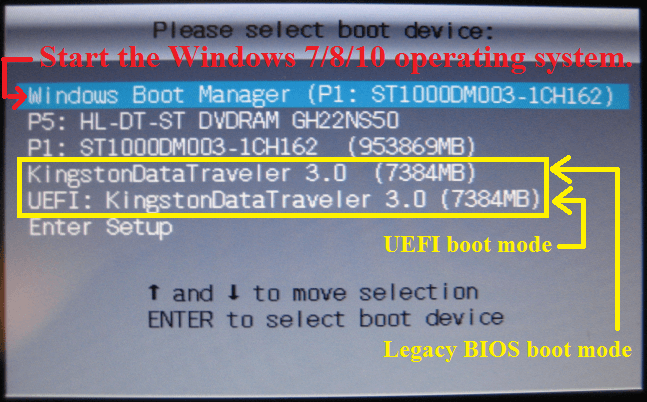- Messages
- 216
"MBR Error 1 - Boot from floppy" after clean 8.1 reinstall
I had previously posted about boot problems with a cloned SSD, which are described in the first post at http://www.eightforums.com/installation-setup/66457-cloned-drive-wont-boot.html. Before I get into more, I suspect this is a hardware issue, either the motherboard (Gigabyte GA-Z97X-UD5H) or the Samsung 850 Pro I got shortly after the mobo. However, for the moment, I want to make sure it's not a Windows issue. Ok...
Earlier this month, I wiped the SSD and did a clean reinstall of Win 8.1 Pro x64, this time using UEFI. Right away, three of the first six boots started with the MBR Error 1 message on first try, then rebooted fine with ctrl-alt-delete (I've seen none of the other boot errors from before). Then the error pretty much went away except occasionally. Now it's back with a vengeance. Just as before the reinstall, when I open BIOS sometimes it shows the system drive and sometimes it doesn't, then all of a sudden it does, and sooner or later starts normally. Along the way, BIOS sometimes shows a different boot order that has to be readjusted. Sometimes at one point the Windows repair screen comes up, but repair fails. One time I tried a recovery repair from a USB stick (unsuccessful), and after that I ended up with another entry in BIOS for the Samsung drive called "Windows Boot Manager Samsung..." What's that?. It's confusing because sometimes that entry shows, sometimes the UEFI Samsung entry shows, sometimes both, but ultimately successful startup doesn't seem to depend on which is present or chosen. In any case, I was just using Diskpart (USB stick) to start a BCD repair, but realized I don't know which is the boot partition (to give a drive letter to). See the drive screenshot. Thanks,

I had previously posted about boot problems with a cloned SSD, which are described in the first post at http://www.eightforums.com/installation-setup/66457-cloned-drive-wont-boot.html. Before I get into more, I suspect this is a hardware issue, either the motherboard (Gigabyte GA-Z97X-UD5H) or the Samsung 850 Pro I got shortly after the mobo. However, for the moment, I want to make sure it's not a Windows issue. Ok...
Earlier this month, I wiped the SSD and did a clean reinstall of Win 8.1 Pro x64, this time using UEFI. Right away, three of the first six boots started with the MBR Error 1 message on first try, then rebooted fine with ctrl-alt-delete (I've seen none of the other boot errors from before). Then the error pretty much went away except occasionally. Now it's back with a vengeance. Just as before the reinstall, when I open BIOS sometimes it shows the system drive and sometimes it doesn't, then all of a sudden it does, and sooner or later starts normally. Along the way, BIOS sometimes shows a different boot order that has to be readjusted. Sometimes at one point the Windows repair screen comes up, but repair fails. One time I tried a recovery repair from a USB stick (unsuccessful), and after that I ended up with another entry in BIOS for the Samsung drive called "Windows Boot Manager Samsung..." What's that?. It's confusing because sometimes that entry shows, sometimes the UEFI Samsung entry shows, sometimes both, but ultimately successful startup doesn't seem to depend on which is present or chosen. In any case, I was just using Diskpart (USB stick) to start a BCD repair, but realized I don't know which is the boot partition (to give a drive letter to). See the drive screenshot. Thanks,

Last edited:
My Computer
System One
-
- OS
- Win 8.1 Pro x64
- Computer type
- PC/Desktop
- System Manufacturer/Model
- DIY
- CPU
- i5 4690K
- Motherboard
- Gigabyte GA-Z97X-UD5H-BK3 (rev. 1.2) UEFI Bios
- Memory
- 16 GB (4x4)
- Graphics Card(s)
- Sapphire Ultimate HD7750
- Sound Card
- JCAT USB
- Monitor(s) Displays
- Dell U2412M
- Screen Resolution
- 1920x1200
- Hard Drives
- Samsung 850 Pro 256 GB SSD
Seagate 3TB, 2TB & 1TB HDDs
- PSU
- Seasonic x650 PSU
- Case
- Cooler Master Elite 335
- Cooling
- Prolimatech Megahalems Rev. C cooler, 3 Nexus Silent Fans
- Keyboard
- IBM Model M
- Mouse
- Bornd Wireless Mouse
- Internet Speed
- 60+ mbps claimed
- Antivirus
- Comodo CIS, MBAM Pro
- Other Info
- PS Audio Directstream dac, Quad 12L powered speakers, Core Audio Tech Kora LPS, JCAT USB card, Uptone Regen USB






